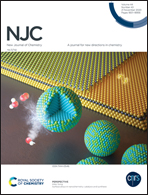Coralline-like CoP3@Cu as an efficient electrocatalyst for the hydrogen evolution reaction in acidic and alkaline solutions†
Abstract
The synthesis of low-cost and efficient electrocatalysts for the hydrogen evolution reaction (HER) is highly challenging. And apart from the intrinsic activity, the structure of the electrocatalysts also plays a vital role in the highly efficient catalysis for the hydrogen evolution reaction. Herein, the H2 bubbling-assisted electroplating method was employed to construct a coralline-like structure of Cu on the copper plate. And then, cobalt phosphide (CoP3) was successfully electrodeposited on the structure to form a CoP3@Cu/Cu electrode. Benefitting from this unique structure, the optimized CoP3@Cu/Cu exhibited an excellent electrocatalytic activity for the HER with Tafel slopes of 44 and 82 mV dec−1 in 0.5 M H2SO4 and 1 M KOH electrolytes, respectively. To reach a current density of 10 mA cm−2, an overpotential of 101 and 92 mV was required for the HER under acidic and alkaline conditions, respectively. Moreover, the CoP3@Cu/Cu electrode exhibited a long-term stability for the HER, indicating a promising prospect in the application.



 Please wait while we load your content...
Please wait while we load your content...